Effect of Different-Diameter Wooden Pins on Mechanical Properties of Triangular Girder Trusses
Abstract
1. Introduction
2. Materials and Methods
2.1. Materials
2.2. Sample Preparation
2.3. Loading System and Device
2.4. Loading Procedure
3. Results and Discussion
3.1. Analysis of Experimental Phenomena
3.2. Data Organization and Analysis
3.2.1. Ultimate Load-Bearing Capacity of the Trusses
3.2.2. Stiffness of the Trusses
3.2.3. Truss Stability
3.2.4. Residual Deformation of the Truss
3.2.5. Energy Dissipation Performance of the Trusses
4. Conclusions
- (1)
- According to the failure results, the wooden pins showed no significant cracking or deformation when damage occurred. This indicates that the pins remained within the elastic range, demonstrating good coordination in the connections of the multiple wooden trusses.
- (2)
- In terms of the overall ultimate load-bearing capacity metrics, the truss connected with 20 mm wooden pins exhibited the best load-bearing capacity.
- (3)
- The stiffness of the wooden trusses connected with wooden pins is in the order of GT-P16 > GT-P18 > GT-P20. The stiffness during the second part of the standard load loading phase (T2) was significantly greater than that during the failure phase (T3), indicating that prolonged loading has a certain impact on the stiffness of wooden trusses.
- (4)
- The stability of the truss connected with the 20 mm wooden pins is the best.
- (5)
- From the perspective of deformation capacity, the double-span wooden trusses connected with the 16 mm and 20 mm wooden pins demonstrated the best resistance to deformation.
- (6)
- The energy dissipation performance is optimal for the truss connected with the 16 mm diameter wooden pins.
Author Contributions
Funding
Data Availability Statement
Acknowledgments
Conflicts of Interest
References
- Lin, S.; Shi, Y. Current status and prospects of prefabricated wooden structures. J. Constr. Sci. Technol. 2019, 1, 46–51. [Google Scholar] [CrossRef]
- Liu, W.; Yang, H. Advances in Modern Wooden Structure Research. J. Build. Struct. 2019, 40, 16–43. [Google Scholar] [CrossRef]
- Madsen, B. Structural Behavior of Timber. 1992. Available online: https://api.semanticscholar.org/CorpusID:136802265 (accessed on 24 April 2013).
- Shi, C. Experimental and Numerical Simulation of the Load-Bearing Capacity of Tooth Plate Connected Lightweight Wooden Trusses. Master’s Thesis, Chongqing University, Chongqing, China, 2011. Available online: https://d.wanfangdata.com.cn/thesis/D282339 (accessed on 24 April 2013).
- Liu, Y.; Fu, M.; Liu, S.; Ge, S.; Liu, Y.; Li, N. Modern Wooden Bridges and Their Structural Forms. J. Archit. Sci. Eng. 2013, 30, 83–91. [Google Scholar] [CrossRef]
- Zhang, J.; Zhong, Y.; Zhao, R.; Zhou, H. Research Progress on the Mechanical Properties of Bolt Connections in Wooden Structures. J. Wood Ind. 2012, 26, 39–42+52. [Google Scholar] [CrossRef]
- Yang, L.; Que, Z. Establishment of Cooperation between Royal Suzhou and Nanjing Forestry University: Research on the Performance of Wood Material in High Temperature, High Humidity, and High Salt Environments. J. Int. Wood Ind. 2013, 8–9. Available online: https://www.cnki.net (accessed on 25 July 2015).
- Que, Z.; Li, Z.; Wang, F.; Wang, Y.; Wang, Y. The Influence of High Salinity Environments on the Shear Performance of Nail-Connected Wooden Structures. J. Ind. Build. 2015, 45, 81–85. [Google Scholar] [CrossRef]
- He, S.; Shang, P.; Yang, B.; Tao, J.; Wei, Y.; Zhu, Y. Shear Performance of Bamboo Nails and Steel Nails Under Corrosion-Induced Treatment. J. For. Sci. Technol. Dev. 2015, 29, 90–94. [Google Scholar] [CrossRef]
- JGJ/T 265-2012; Technical Specification for Lightweight Wooden Trusses. China Architecture & Building Industry Press: Beijing, China, 2012.
- Gupta, R.; Vatovec, M.; Miller, T.H. Metal-Plate-Connected Wood Joints: A Literature Review; Forest Research Laboratory Oregon State University: Corvallis, OR, USA, 1996; Available online: https://wur.on.worldcat.org/oclc/34647918 (accessed on 1 January 1996).
- Barron, K.C.; Kim, J.B. Non-linear modeling of the heel joint of metal plate connected roof trusses. In Proceedings of the World Conference on Timber Engineering, Whistler Resort, BC, Canada, 31 July–3 August 2000; Volume 7. [Google Scholar]
- Lau, P.W.C. Factors affecting the behaviour and modelling of toothed metal-plate joints. Can. J. Civ. Eng. 1987, 14, 183–195. [Google Scholar] [CrossRef]
- O’Regan, P.J.; Woeste, F.E.; Lewis, S.L. Design procedure for the steel net-section of tension splice joints in MPC wood trusses. For. Prod. J. 1998, 48, 35–42. [Google Scholar]
- Colonias, K.W. Multiple Wood Truss Connection. U.S. Patent 4,890,436, 1 February 1990. [Google Scholar]
- Bugbee, M.W.; Colonias, K.W. Light Wood Truss Connection. U.S. Patent 5,042,217, 27 August 1991. [Google Scholar]
- Sejkot, P.; Ormarsson, S.; Vessby, J.; Källsner, B. Numerical out-of-plane stability analysis of long span timber trusses with focus on buckling length calculations. Eng. Struct. 2020, 204, 109670. [Google Scholar] [CrossRef]
- Xu, X. Research on the Load-Bearing Capacity of Lightweight Wooden Trusses. Master’s Thesis, Tongji University, Shanghai, China, 2006. Available online: https://doi.org/10.7666/d.y846616 (accessed on 15 June 2006).
- Kuang, Y. Experimental Study on the Stress Performance of Tooth Plate Connection Joints in Lightweight Wooden Trusses. Master’s Thesis, Chongqing University, Chongqing, China, 2011. Available online: https://d.wanfangdata.com.cn/thesis/D282934 (accessed on 15 January 2012).
- Huang, H.; He, M. Experimental Research on the Structural Performance of Lightweight Wooden Truss Systems. J. Jiamusi Univ. (Nat. Sci. Ed.) 2009, 27, 481–485+492. [Google Scholar] [CrossRef]
- Che, Y. Research on Testing Methods and Loading Procedures for Metal Tooth Plate Connected Lightweight Wooden Trusses. Master’s Thesis, Chongqing University, Chongqing, China, 2013. Available online: https://doi.org/10.7666/d.D353874 (accessed on 31 October 2013).
- Gao, Y. Design and Optimization of Connection Joints in Multiple Wooden Trusses. Master’s Thesis, Nanjing Forestry University, Nanjing, China, 2017. [Google Scholar]
- Chen, Q.; Teng, Q.; Gao, Y.; Zeli, Q. The Impact of Member Arrangement on the Load-Bearing Capacity of Parallel Chord Wooden Trusses. J. Wood Ind. 2017, 31, 20–25. [Google Scholar] [CrossRef]
- Que, Z.; Gao, Y.; Ge, S. Research status and development trend of multiple wooden trusses. J. For. Eng. 2017, 2, 138–144. [Google Scholar] [CrossRef]
- GB/T 50329-2012; Standard Test Methods for Timber Structures. The Ministry of Construction of the People’s Republic of China Press: Beijing, China, 2012.
- Chang, C.; Que, Z.; Liu, Y.; Hou, T.; Chen, L.; Wang, X.; Yao, Z. A Truss Loading Device. P. Jiangsu Province CN. 201810405679, 24 November 2023. [Google Scholar]
- GB5009−2012; Code for the Design Loading of Building Structures. China Architecture & Building Industry Press: Beijing, China, 2012.
- Wang, F.; Teng, Q.; Gao, Y.; Chen, Q.; Wang, C.; Zeli, Q. Static load test and bearing capacity of multiple wooden trusses. J. Civil Environ. Eng. 2019, 41, 86–92. [Google Scholar] [CrossRef]

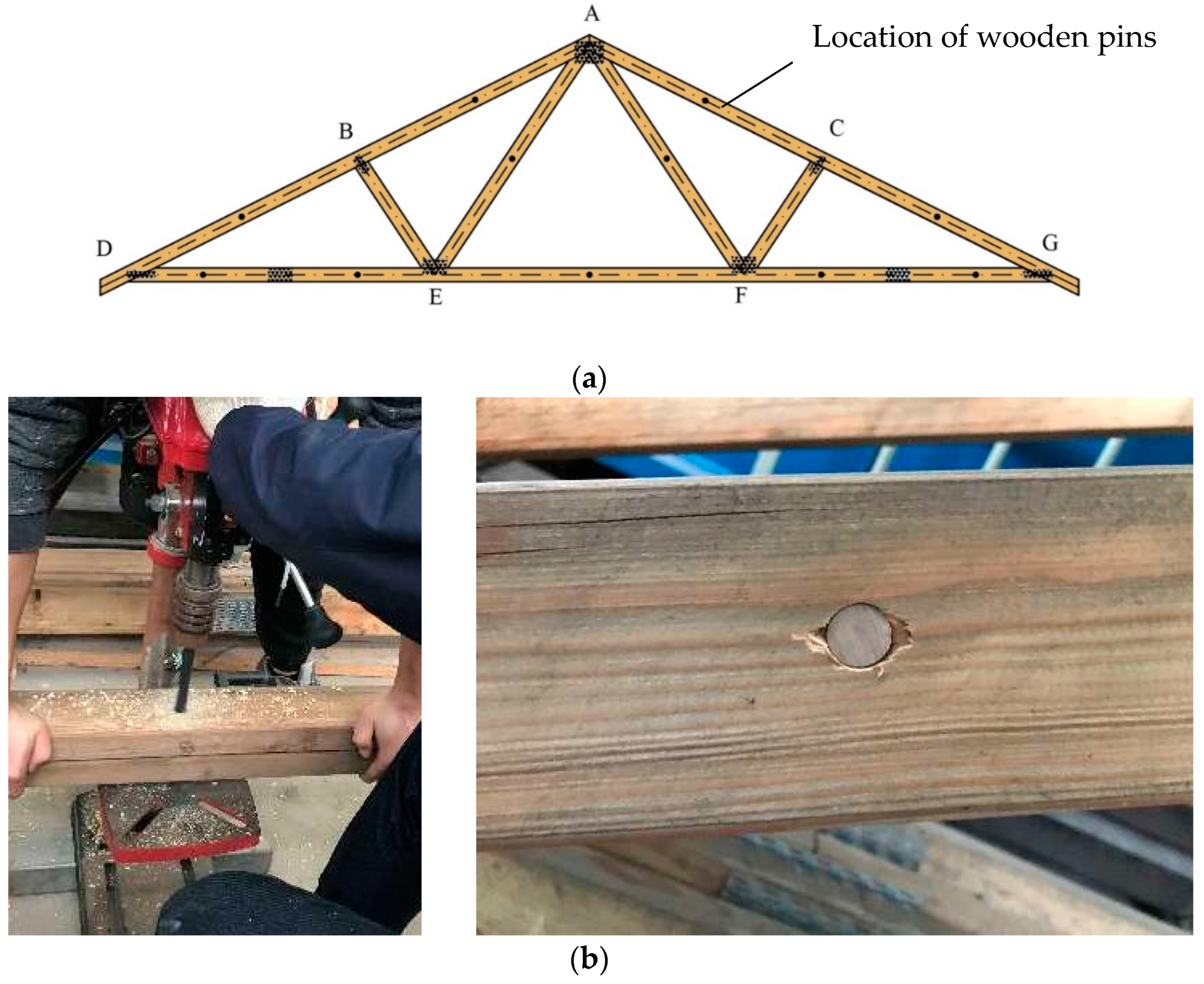

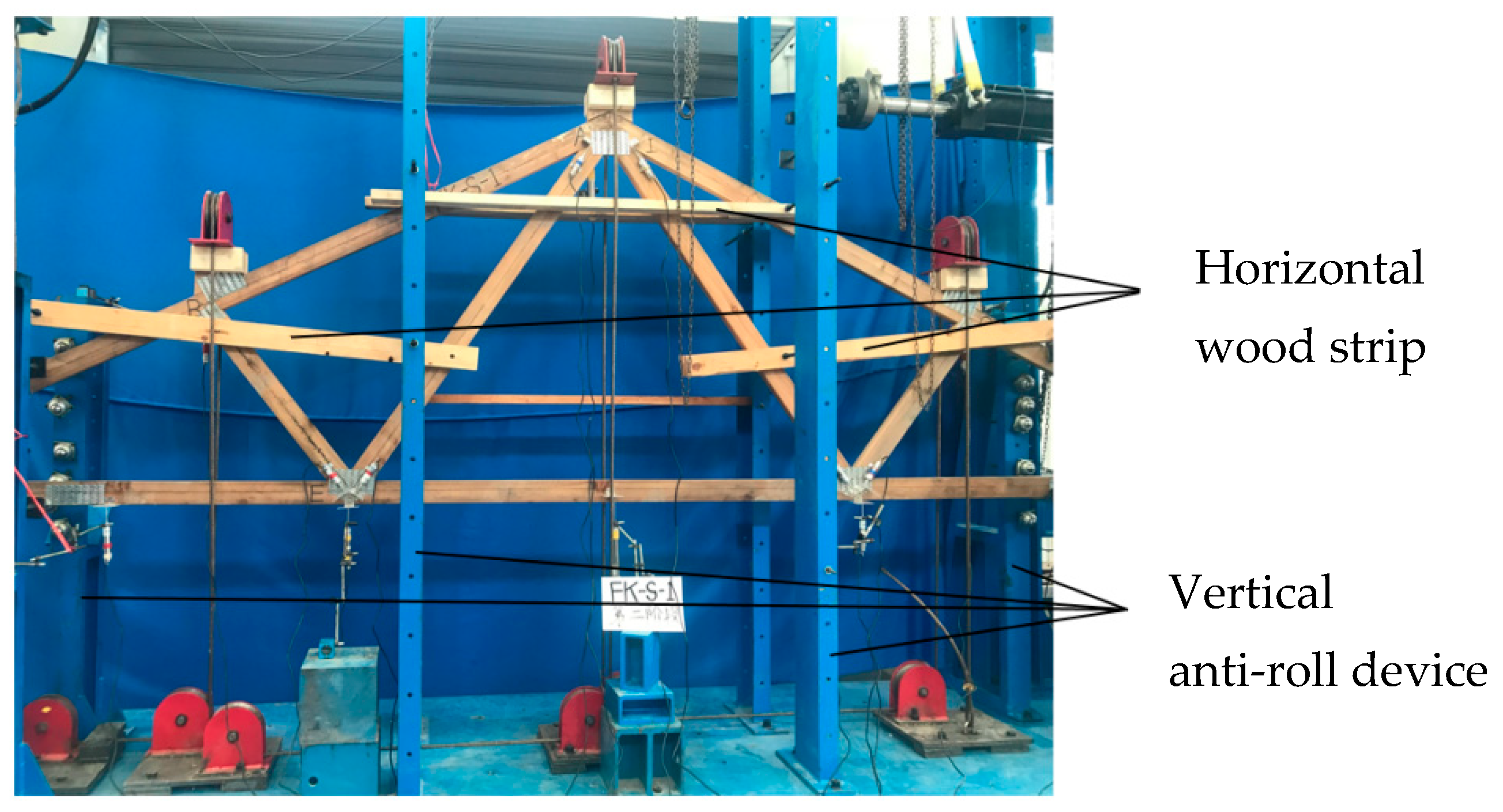
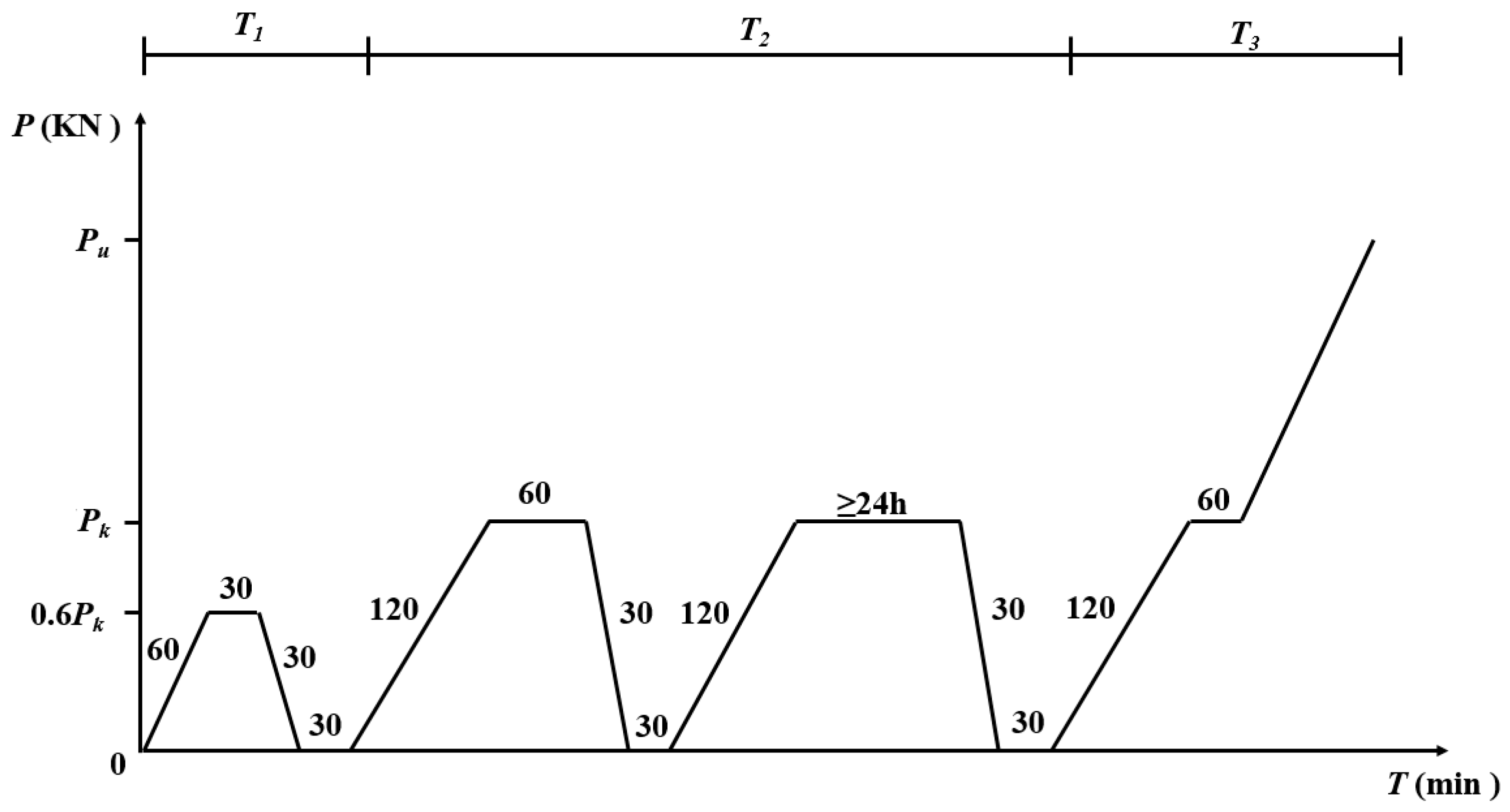

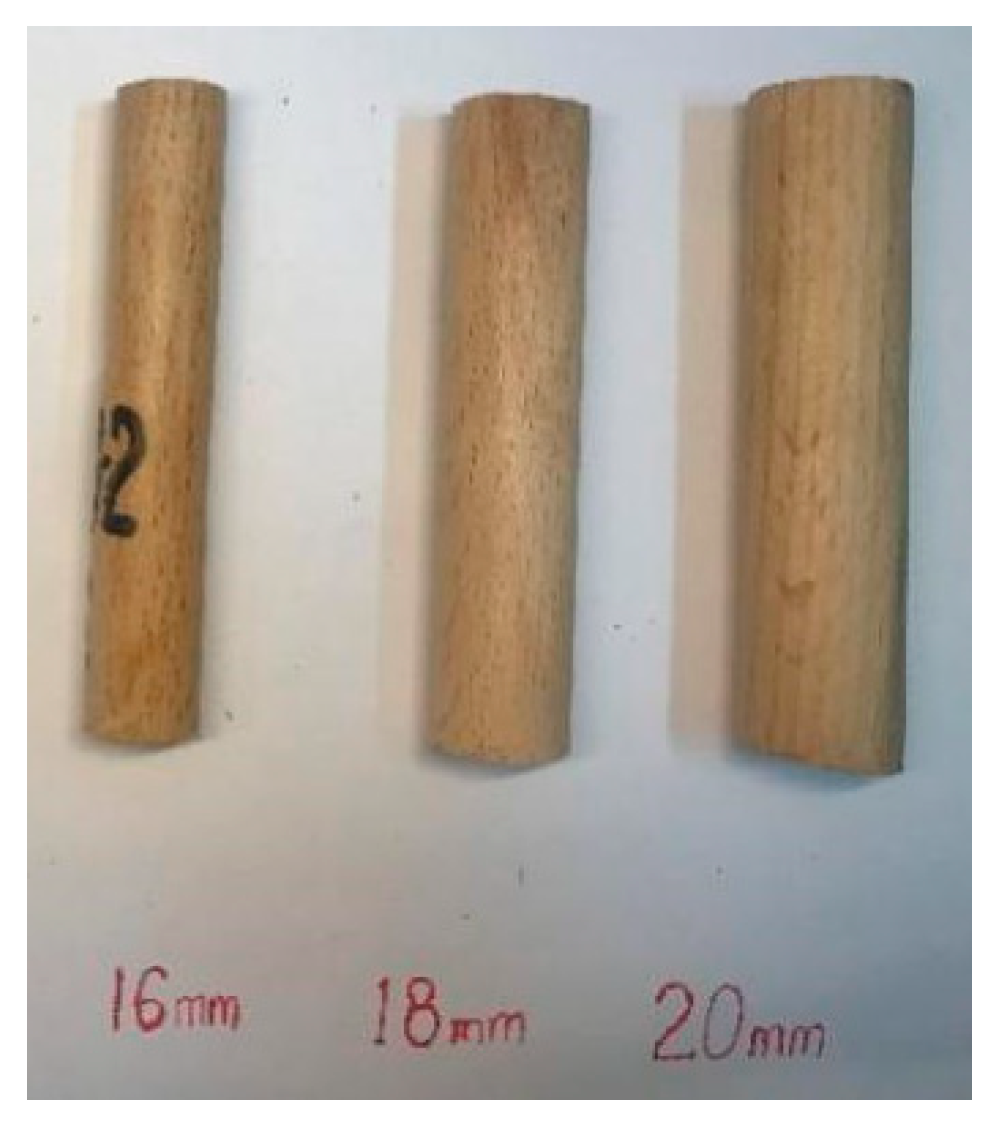
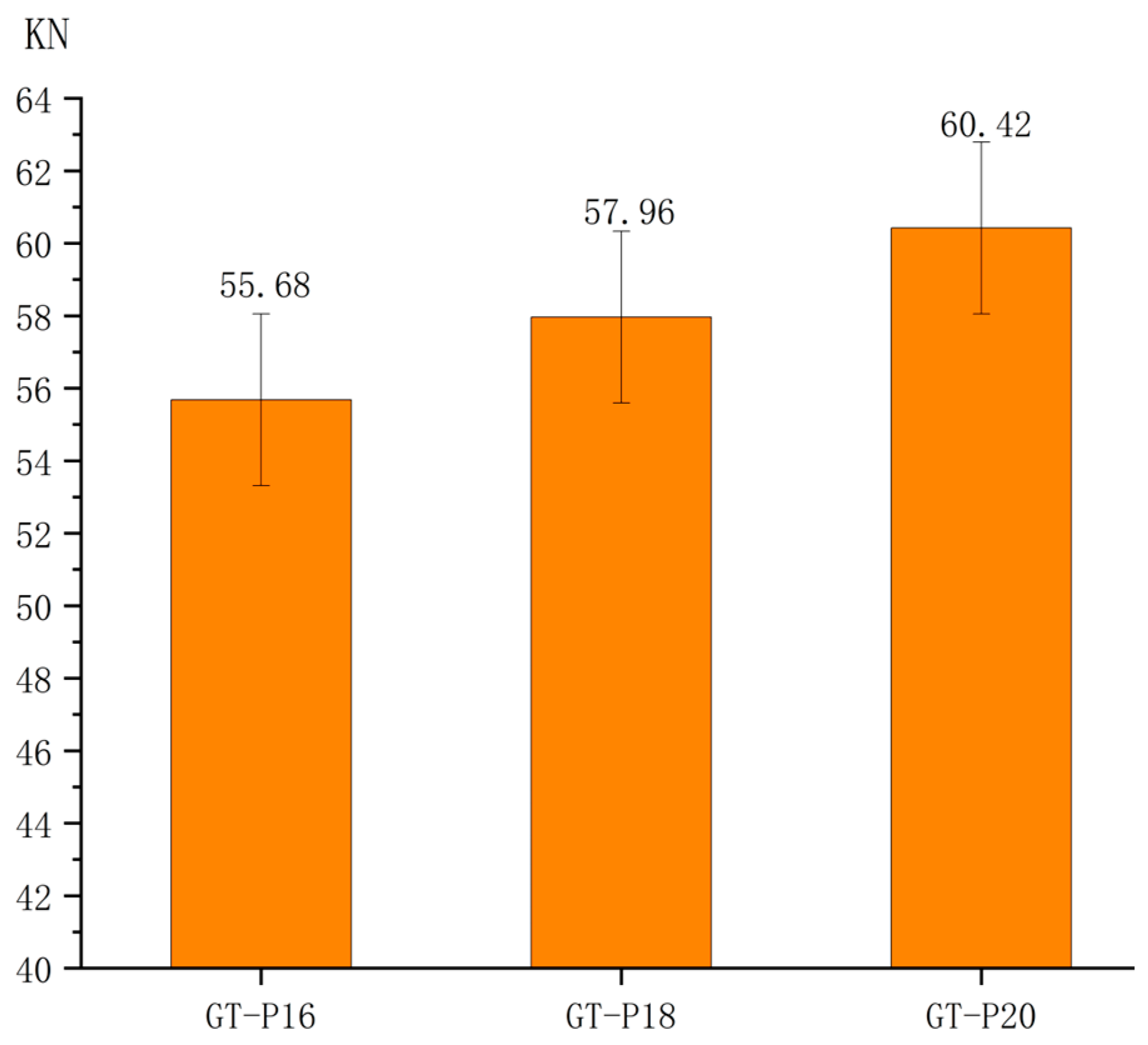

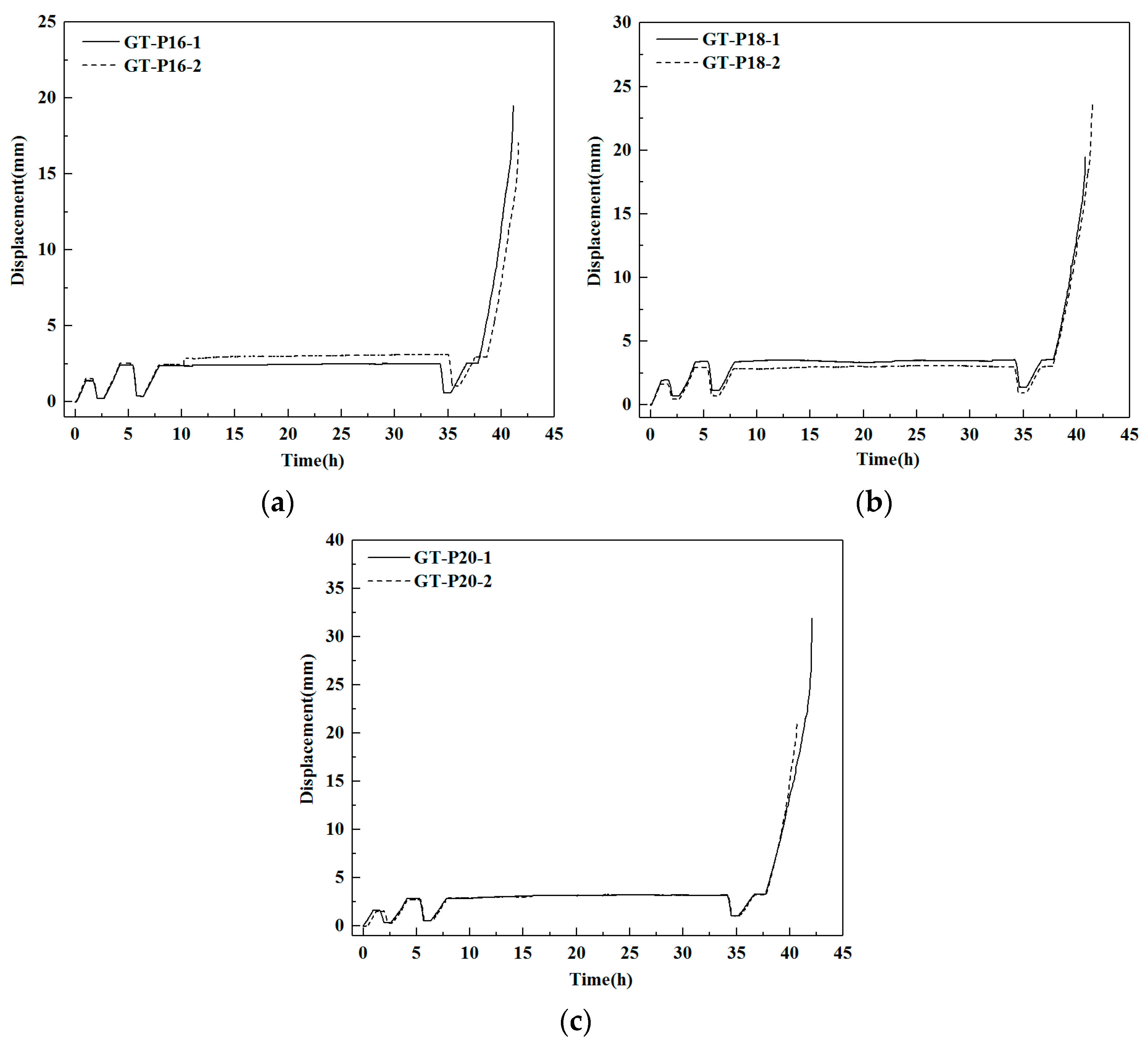

| Modulus of Elasticity | Flexural Strength | Compressive Strength Along Grain | Tensile Strength Along Grain | Transverse Compressive Strength |
|---|---|---|---|---|
| 12220.9 ± 6.21 * | 85.32 ± 1.18 * | 45.15 ± 4.3 * | 10.21 ± 1.25 * | 7.6 ± 1.8 * |
| Tooth Plate Thickness(mm) | Density of Plate Teeth (Each/mm2) | Length of Plate Teeth (mm) | Elastic Modulus of Steel (GPa) | Tensile Yield Strength of Steel (MPa) |
|---|---|---|---|---|
| 0.90 | 0.012 | 8.6 | 203 | 248 |
| Number of Trusses | Double Truss | ||
|---|---|---|---|
| The diameter of the wooden pins at the connection between wooden trusses. | Wooden pin with diameter of 16 mm | Wooden pin with diameter of 18 mm | Wooden pin with diameter of 20 mm |
| Number | 2 | 2 | 2 |
| Identifier of truss | GT-P16-1 GT-P16-2 | GT-P18-1 GT-P18-2 | GT-P20-1 GT-P20-2 |
| Identifier of Truss | Node A | Node B | Node C | Midspan K Node | Node E | Node F | Average | Standard Deviation |
|---|---|---|---|---|---|---|---|---|
| GT-P16 | 1.82 | 2.09 | 1.83 | 1.48 | 1.74 | 1.78 | 1.64 | 0.196 |
| GT-P18 | 1.25 | 1.15 | 1.51 | 1.21 | 1.45 | 1.60 | 1.43 | 0.183 |
| GT-P20 | 1.42 | 1.44 | 1.44 | 1.19 | 1.35 | 1.57 | 1.34 | 0.126 |
| Identifier of Truss | Midspan | Node A | Node B | Node C | Node E | Node F |
|---|---|---|---|---|---|---|
| GT-P16 | 0.24 | 0.53 | 0.51 | 0.31 | 0.15 | 0.21 |
| GT-P18 | 0.59 | 0.69 | 0.71 | 0.56 | 0.56 | 0.56 |
| GT-P20 | 0.33 | 0.29 | 0.69 | 0.38 | 0.34 | 0.15 |
| Identifier of Truss | Midspan | Node A | Node B | Node C | Node E | Node F |
|---|---|---|---|---|---|---|
| GT-P16 | 0.37 | 0.83 | 0.75 | 0.53 | 0.3 | 0.34 |
| GT-P18 | 0.93 | 1.04 | 1.29 | 0.83 | 0.76 | 0.87 |
| GT-P20 | 0.56 | 0.59 | 0.99 | 0.54 | 0.54 | 0.3 |
| Identifier of Truss | Midspan | Node A | Node B | Node E | Node F | Average | Standard Deviation |
|---|---|---|---|---|---|---|---|
| GT-P16 | 0.82 | 1.29 | 1.31 | 0.66 | 0.70 | 0.956 | 0.286 |
| GT-P18 | 0.97 | 1.31 | 1.54 | 1.12 | 1.04 | 1.196 | 0.215 |
| GT-P20 | 1.05 | 1.02 | 1.23 | 0.85 | 0.55 | 0.94 | 0.233 |
| Identifier of Truss | Node A | Node B | Node C | Midspan | Node E | Node F | Average |
|---|---|---|---|---|---|---|---|
| GT-P16 | 3.77 | 4.37 | 3.60 | 5.21 | 2.91 | 3.30 | 3.86 |
| GT-P18 | 4.31 | 3.81 | 3.53 | 4.06 | 3.08 | 2.79 | 3.60 |
| GT-P20 | 2.01 | 3.06 | 2.51 | 4.70 | 2.53 | 2.34 | 2.86 |
Disclaimer/Publisher’s Note: The statements, opinions and data contained in all publications are solely those of the individual author(s) and contributor(s) and not of MDPI and/or the editor(s). MDPI and/or the editor(s) disclaim responsibility for any injury to people or property resulting from any ideas, methods, instructions or products referred to in the content. |
© 2024 by the authors. Licensee MDPI, Basel, Switzerland. This article is an open access article distributed under the terms and conditions of the Creative Commons Attribution (CC BY) license (https://creativecommons.org/licenses/by/4.0/).
Share and Cite
Yue, Y.; Wang, S.; Chang, C.; Ma, P.; Wang, F.; Wang, Z.; Que, Z. Effect of Different-Diameter Wooden Pins on Mechanical Properties of Triangular Girder Trusses. Forests 2024, 15, 1675. https://doi.org/10.3390/f15091675
Yue Y, Wang S, Chang C, Ma P, Wang F, Wang Z, Que Z. Effect of Different-Diameter Wooden Pins on Mechanical Properties of Triangular Girder Trusses. Forests. 2024; 15(9):1675. https://doi.org/10.3390/f15091675
Chicago/Turabian StyleYue, Yanming, Shuo Wang, Cheng Chang, Panpan Ma, Feibin Wang, Zhenlu Wang, and Zeli Que. 2024. "Effect of Different-Diameter Wooden Pins on Mechanical Properties of Triangular Girder Trusses" Forests 15, no. 9: 1675. https://doi.org/10.3390/f15091675
APA StyleYue, Y., Wang, S., Chang, C., Ma, P., Wang, F., Wang, Z., & Que, Z. (2024). Effect of Different-Diameter Wooden Pins on Mechanical Properties of Triangular Girder Trusses. Forests, 15(9), 1675. https://doi.org/10.3390/f15091675







